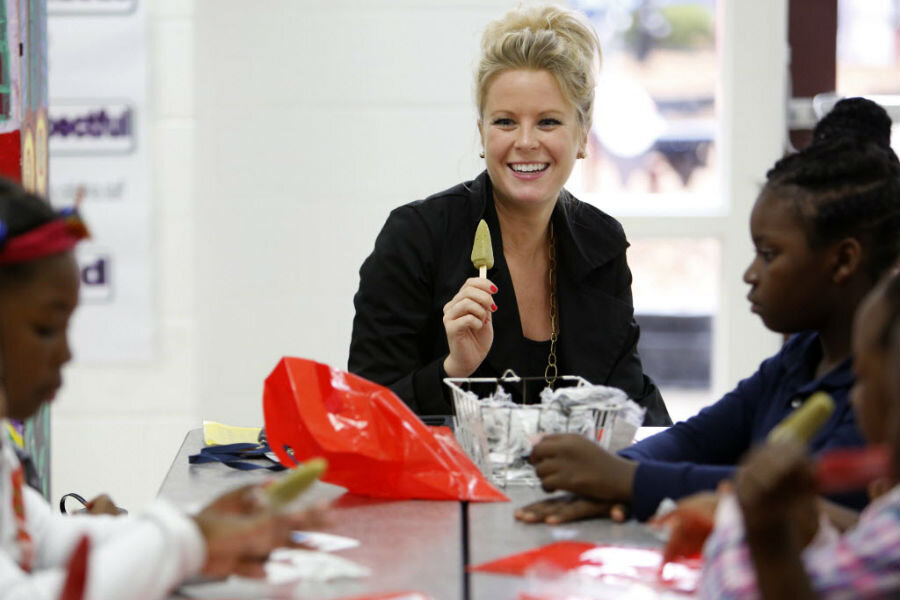Can Giving Tuesday counterbalance holiday commercialism?
Loading...
| Los Angeles
Darrell Hamen says he has very little silver or gold, but what he does have, he’s ready to give.
“My psyche and soul feel really lopsided right now and are seeking equilibrium,” says the former teacher, now screenwriter, working on a screenplay at the corner coffee shop. Urged by an online ad that just popped into his email, he’s headed home to mine his closets and bureaus for jeans, socks, shoes, and scarves that he never uses … and take them to the local Goodwill.
“It was pleasant and cute, and made me think,” he says, talking of the animated, 1-1/2 minute “Giving Tuesday 2014” video he just played, which mentioned a whole range of options besides just giving money – time, kind words, a Tweet, a seat on the bus – any way to help someone. “What I like about this day is that it reverses the polarity of everything,” he says, and shifts the focus “from me, me, me, to everybody else.”
A growing number of individuals and organizations are reporting the same sentiments and expressing gratitude for Giving Tuesday as a formal antidote to the rise of consumer holidays in America known as Black Friday and Cyber Monday.
Giving Tuesday was created just two years ago by the 92nd Street Y in New York and the United Nations Foundation, and has since been adopted by a growing team of influencers, companies, and foundations. It has already become a formal part of many corporate and business annual giving profiles, engaging more than 10,000 organizations and millions of people.
One is DreamFund.com, a Boston-based crowdfunding platform that this year is participating in the Giving Tuesday movement by creating specialized templates for users who want to create a crowdfunding campaign for their favorite charity or non-profit organization.
"I think of #GivingTuesday as like eating a fresh, delightful salad on the day after Thanksgiving,” said Peter Crosby, chief marketing officer of DreamFund, in an e-mail interview. “It shakes off the bloat and slightly self-centered nature of the shopping and feasting, and turns it back towards each other.”
He and others say the movement has been amplified by the power of social media.
“Giving is a very personal thing,” he says. “While many people have mixed feelings about the social phenomenon that is Black Friday, Giving Tuesday already has proved itself as a much-needed holiday and social movement that the masses want to support.”
His feelings are echoed by Ripon College’s Melissa Anderson, executive director of marketing and communications, who has formally incorporated the day into the school’s Alumni Relations efforts and Annual Fund to support the operations of the college.
“We think #GivingTuesday is a great idea because it allows us another touch point with alumni and donors that isn't necessarily all about asking for money,” Ms. Anderson says in an e-mail interview. “We look at #GivingTuesday as really an anchor to the Thanksgiving holiday season, which is all about being thankful for the people, places, and experiences that have helped shape us as individuals.”
Anderson says Giving Tuesday has helped boost the college’s social media engagement with donors. “We do feel like we've definitely ‘pulled forward’ a few online gifts during this Thanksgiving season and increased participation since we started to participate in #GivingTuesday in 2013.”
Tom Watson, author of "CauseWired: Plugging In, Getting Involved, Changing the World," thinks #GivingTuesday has arrived and is here to stay.
“GivingTuesday is becoming cultural,” he writes in a Forbes blog. “Many companies are on board in the workplace. The White House is urging participation. MSNBC is fully integrating its program schedule this week. Many states and cities have their own GivingTuesday efforts underway.”
The phenomenon has gained significant traction on social media. The Twitter hashtag #GivingTuesday was Tweeted up to 700 times per minute at its peak Tuesday, according to givingtuesday.org.
“Call it the Philanthropy Super Bowl in development,” says DreamTime’s Crosby. “All of this portends a major reckoning for the broadly-defined social sector and what we think of as giving and volunteering and organizing.”
Others are not so sure.
“I think it's a little troubling how much public credit we seem to want in exchange for an act of charity. And how much packaging it takes,” Ron Bishop, head of the Department of Culture and Communication at Drexel University writes in an e-mail.
In a paper he wrote about a Goodwill TV campaign, he used the term "sanitary act": “You get to feel good, receive the congratulations of your peers, but do little to address the underlying problems that create the need for the campaign in the first place. It would be nice if we could just give and not expect plaudits/do it publicly.”





